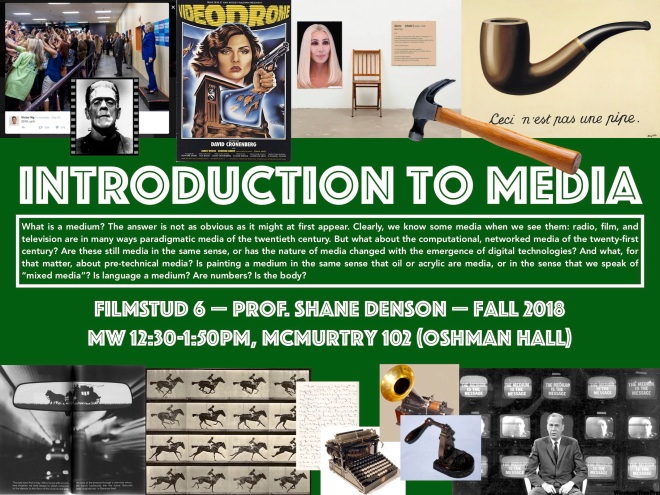
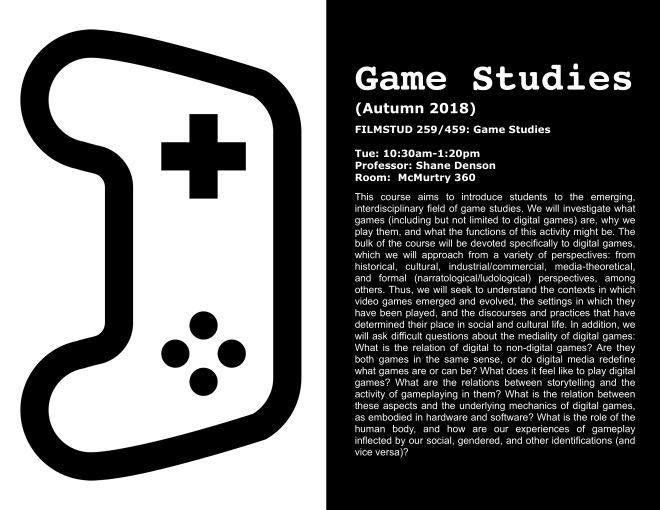


About two years ago, the exhibition On Display: Immemory, Soft Cinema, After Video at Bilkent University in Ankara brought together projects by Chris Marker, Lev Manovich, and the contributors to the “video book” after.video — including the collaborative AR piece “Scannable Images” that Karin Denson and I made. Recently, Oliver Lerone Schultz (one of the editors of after.video) brought to my attention this “critical tour” of the exhibition, which takes the form of a discussion between Ersan Ocak and Andreas Treske. It is audio only, and you might need to turn up the volume a bit, but it’s an interesting discussion of video and media art.
(See here for more on after.video. Also, I should note that the AR on “Scannable Images” is currently not working due to the ephemeral business models of AR platforms these days, but I hope to port it over to a new platform and get it up and running again soon!)
I am excited to be participating in the the NEH-funded Virtual and Augmented Reality Digital Humanities Institute — or V/AR-DHI — next month (July 23 – August 3, 2018) at Duke University. I am hoping to adapt “deformative” methods (as described by Mark Sample following a provocation from Lisa Samuels and Jerome McGann) as a means of transformatively interrogating audiovisual media such as film and digital video in the spaces opened up by virtual and augmented reality technologies. In preparation, I have been experimenting with photogrammetric methods to reconstruct the three-dimensional spaces depicted on two-dimensional screens. The results, so far, have been … modest — nothing yet in comparison to artist Claire Hentschker’s excellent Shining360 (2016) or Gregory Chatonsky’s The Kiss (2015). There is something interesting, though, about the dispersal of the character Neo’s body into an amorphous blob and the disappearance of bullet time’s eponymous bullet in this scene from The Matrix, and there’s something incredibly eerie about the hidden image behind the image in this famous scene from Frankenstein, where the monster’s face is first revealed and his head made virtually to protrude from the screen through a series of jump cuts. Certainly, these tests stand in an intriguing (if uncertain) deformative relation to these iconic moments. In any case, I look forward to seeing where (if anywhere) this leads, and to experimenting further at the Institute next month.
The new issue of Media Fields, devoted to the topic of “Mediating the Anthropocene,” is out now. Included among the many exciting contributions is my article “Post-Cinema After Extinction.” Check out the whole issue here.
Congratulations to Carlos Valladares, who not only graduated with honors from the Stanford Film & Media Studies program this past weekend, but whose video essay “Minnelli Red” was accepted at the Pesaro Film Festival taking place right now in Pesaro, Italy!
Valladares’s video essay, a revised version of his final project for the seminar I taught on “The Video Essay: Writing with Video about Film and Media” last fall, is one of five entries selected by curators Chiara Grizzaffi and Andrea Minuz in the festival’s “(Re)Edit Competition” and is now in the running for a juried award. Good luck, Carlos!
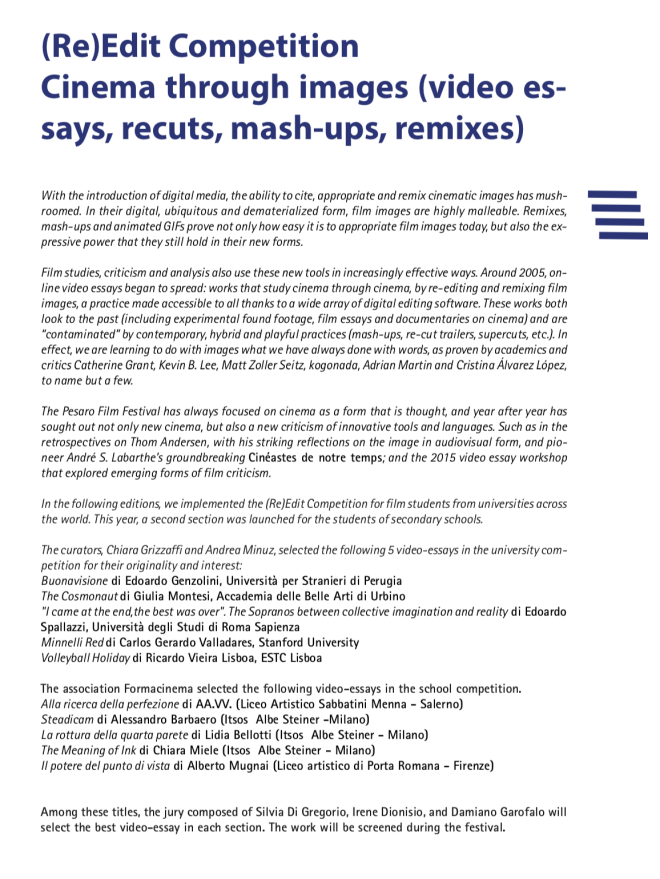
The complete catalog (PDF) for the 54th Pesaro Film Festival is available here:
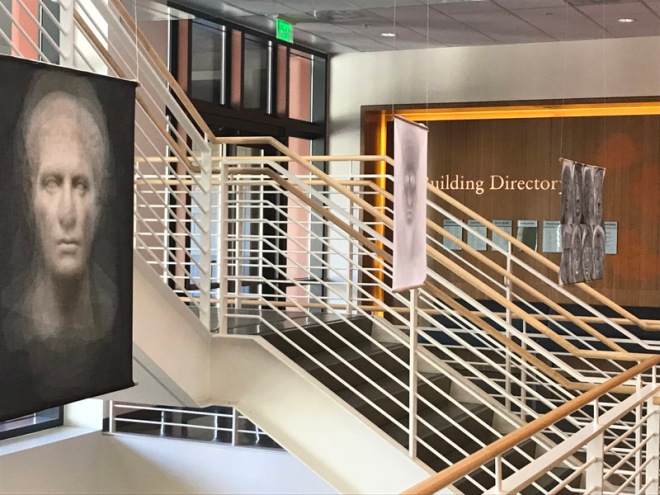
Works from the course “Let’s Make a Monster: Critical Making,” which I co-taught this quarter with my art practice colleague Paul DeMarinis, are currently on display in the Shriram Center for Bioengineering and Chemical Engineering at Stanford University. The show, which officially opened today, is up through Friday, June 8.
We are particularly excited to take this work across campus and show it in the context of a space devoted to cutting-edge engineering work, where we hope that it provokes thought and discussion about the transformations of technology, experience, and life itself taking place in Silicon Valley and elsewhere. Thanks especially to Prof. Drew Endy for his help in facilitating and making this show possible.
Here are just a few glimpses of the work on display.
Nora Wheat, Decode (2018)
Hieu Minh Pham, The Knot (2018)
Raphael Palefsky-Smith, Brick (2018) — more info here
David Zimmerman, Eigenromans I-III (2018)
Jennifer Xilo, Mirror for Our Upturned Palms (2018)
Jackie Langelier, Creepers (2018)
My student Spencer Slovic has just published an excellent video essay on “Slowness and Slow Cinema” at Film Matters, which will be of interest to people thinking about contemporary and world cinema, or simply interested in the medium of the video essay (and this is a very good one!).
Spencer’s video grew out of an assignment for my “Post-Cinema” seminar, which I taught in the winter quarter of 2017. An earlier version was featured in the exhibition I curated at Stanford, Post-Cinema: Videographic Explorations (you can still see all of the videos online).
In any case, the version featured in Film Matters is much improved, having gone through a rigorous peer-review process. Take a look!
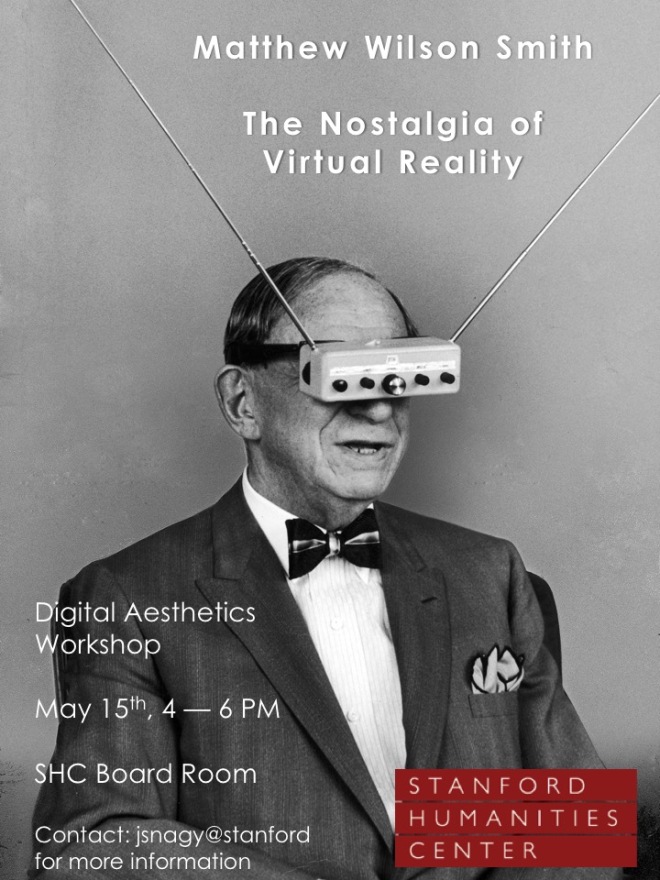
On Tuesday, May 15th, we’ll have our fourth and final Digital Aesthetics Workshop of the Spring quarter, “The Nostalgia of Virtual Reality” with Matthew Wilson Smith, at 4 PM in the Stanford Humanities Center Board Room. In this workshop, we will discuss the degree to which emergent technologies of virtual reality are indebted to longstanding concepts of presence and disembodied consciousness.
Matthew Wilson Smith is an Associate Professor of German Studies and Theatre and Performance Studies at Stanford University. His interests include modern theatre; modernism and media; and relations between technology, science, and the arts. His book The Nervous Stage: 19th-century Neuroscience and the Birth of Modern Theatre explores historical intersections between the performing arts and the neurological sciences and traces the construction of a “neural subject” over the course of the nineteenth century. It was published by Oxford University Press in 2017. His previous book, The Total Work of Art: From Bayreuth to Cyberspace (Routledge, 2007), presents a history and theory of modern artistic synthesis, placing such diverse figures as Wagner, Moholy-Nagy, Brecht, Riefenstahl, Disney, Warhol, and contemporary cyber-artists within a genealogy of totalizing performance.
Somehow I forgot to post the syllabus for “Let’s Make A Monster! Critical Making,” which Paul DeMarinis and I are currently teaching as a hybrid Film & Media Studies and Art Practice class in the Department of Art & Art History at Stanford. The main focus of the course, as the title indicates, is the production of monsters in a variety of media and informed by reading literary, philosophical, and other critical texts on making and monstrosity. Students have been making some truly astounding work, and I look forward to being able to present some of it later in the quarter. We will be organizing an exhibition of works on campus, and I will post images here.
There is a new review of several works on all things post-cinematic, including Post-Cinema: Theorizing 21st-Century Film (which I co-edited with Julia Leyda), alongside Francesco Casetti’s The Lumière Galaxy; Malte Hagener, Vinzenz Hediger, and Alena Strohmaier’s edited collection The State of Post-Cinema; Vinzenz Hediger and Miriam de Rosa’s special issue Post-What? Post-When?; and Astrid Deuber-Mankowsky’s Queeres Post-Cinema.
The review, in German, is titled “Werden/Weiter/Denken: Rekapitulation eines Post-Cinema Diskurses” (roughly: Becoming/Further/Thinking — suggesting a thinking in flux and a thinking beyond — Recapitulation of a Post-Cinema Discourse). The text, by Elisa Linseisen from the Ruhr-Universität Bochum, appears in Zeitschrift für Medienwissenschaft 18 (2018). The full text is available as an open-access PDF.